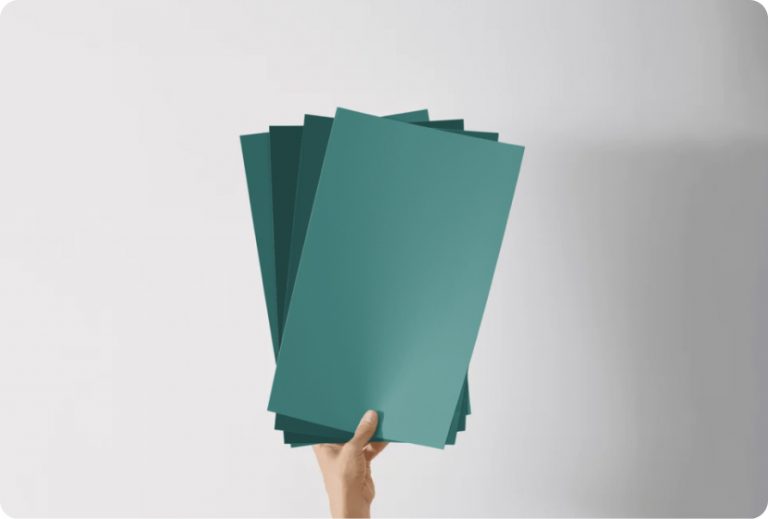I recently came across Benjamin Moore’s 2115-10 Appalachian Brown and felt compelled to share my thoughts about this distinct shade. If you’re searching for a rich, deep brown that brings a sense of warmth and grounding to a room, this might be the perfect pick for you. The color has a unique earthiness that makes it incredibly adaptable; it can complement a rustic aesthetic just as well as it can enhance a more modern setting.
In my experience, using Appalachian Brown in a room adds a layer of refinement without making the area feel too dark or heavy. Its ability to act as both a standout feature and a subtle backdrop makes it a fantastic choice for anyone looking to refresh their interiors.
Whether you’re considering a new color for your living room walls or thinking about revamping the look of your furniture, Appalachian Brown provides a solid foundation that pairs beautifully with a wide range of colors and textures.
So, if you have been looking for a color that adds depth and character, give Appalachian Brown by Benjamin Moore a try. It might just reshape your room in ways you hadn’t imagined.

What Color Is Appalachian Brown 2115-10 by Benjamin Moore?
Appalachian Brown by Benjamin Moore is a deep, rich brown that exudes warmth and comfort in any room it graces. This color is adaptable, making it an excellent choice for creating a cozy, welcoming atmosphere in homes or businesses. It has a grounding effect, providing a strong foundation that can be paired with a variety of color palettes.
This brown shade works exceptionally well in interior styles such as rustic, traditional, and modern farmhouse. It brings out the best in environments where wood plays a major role, enhancing the natural beauty of wooden beams, floors, and furniture.
Appalachian Brown also pairs beautifully with materials like leather and wool, adding depth and texture to the design. When matched with creamy whites or soft beige, it creates a comfortable and stylish contrast.
In terms of textures, Appalachian Brown aligns well with smooth satin finishes that reflect a bit of light and prevent the room from feeling too dark. Additionally, incorporating elements like plush throws or rugged rugs can add interesting visual layers to the interior, making it feel lived-in and inviting.
Overall, Appalachian Brown is a dynamic choice that works brilliantly in numerous design settings, complementing various materials and enhancing textural elements for a well-rounded and appealing look.

Is Appalachian Brown 2115-10 by Benjamin Moore Warm or Cool color?
Appalachian Brown from Benjamin Moore is a warm, deep brown color that adds a cozy feel to any room. This hue brings a sense of comfort and can make large areas feel more intimate. It works well in living rooms or dens where you want to create a snug, inviting atmosphere.
Because it’s a darker shade, it pairs nicely with lighter colors like soft beige or creamy whites for a nice contrast that brightens the area. In homes with a lot of natural light, Appalachian Brown stays true to its rich tones without making the room feel too heavy.
For smaller areas, using it on an accent wall is a great way to incorporate the color without making the room feel smaller. It’s also highly adaptable, fitting well with various styles, whether you’re going for a rustic look or something more modern.
Undertones of Appalachian Brown 2115-10 by Benjamin Moore
Appalachian Brown is a unique paint color that blends a range of subtle undertones. This richness in undertones can greatly influence how the color appears in different settings. In general, undertones are the underlying hues that subtly affect the main shade, ultimately shaping the overall look and feel of the paint when applied.
Undertones of brown, dark green, navy, olive, purple, dark turquoise, and gray make Appalachian Brown an adaptable color. Each undertone contributes to the depth and complexity of the shade. For example, brown undertones enhance warmth, making a room feel cozy.
Dark green and olive bring a touch of nature and freshness, while navy adds a hint of depth. Purple undertones can introduce a slightly mysterious feel, and dark turquoise offers a sense of calm. Gray, being neutral, balances the intensity of the other undertones.
When used on interior walls, Appalachian Brown creates a dynamic interplay with light. In natural daylight, the green and turquoise undertones might become more pronounced, giving the room a crisp look.
In artificial lighting, the warmer brown and olive tones might take the lead, providing a welcoming and comfortable atmosphere. The adaptability of this color allows it to suit various decor styles and preferences, from classic to contemporary, making it a practical choice for many homes.

What is the Masstone of the Appalachian Brown 2115-10 by Benjamin Moore?
Appalachian Brown 2115-10 by Benjamin Moore has a masstone of dark grey, characterized by its deep, almost charcoal color. In homes, this shade provides a strong, grounding effect, making it a popular choice for creating a cozy and secure atmosphere.
As a neutral color, it pairs well with a wide range of other hues, allowing for flexibility in decorating. This adaptability makes it ideal for living areas, bedrooms, and even exteriors, giving rooms a solid, reassuring presence.
The richness of this color adds depth to walls, often making rooms feel more enclosed and intimate, which can be particularly appealing in larger areas that need a touch of warmth. Furthermore, the dark grey masstone can help in concealing marks and smudges, making it a practical choice for busy households. Overall, this color is excellent for anyone looking to create a comforting, grounded environment in their home.
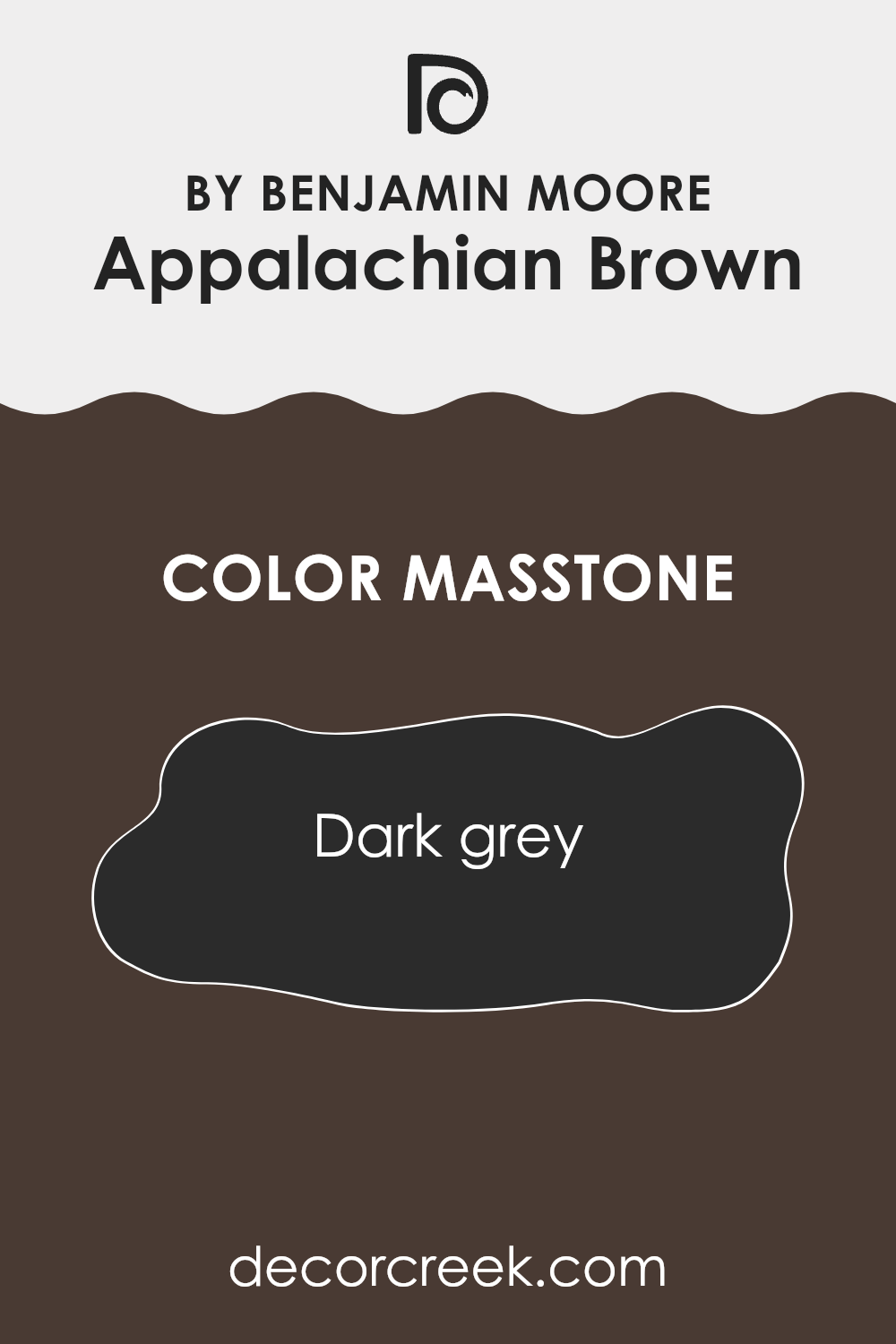
How Does Lighting Affect Appalachian Brown 2115-10 by Benjamin Moore?
Lighting significantly influences how we perceive colors in different environments. The color perception can change when viewed under various types of light sources. For example, the paint color Appalachian Brown by Benjamin Moore can appear differently under artificial and natural lighting conditions.
In artificial light, such as LED or fluorescent lighting, Appalachian Brown tends to look warmer, highlighting its darker, richer tones. This can make a room feel cozy and intimate, especially in areas where warmer light bulbs are used. In contrast, under bright, white artificial light, this shade might lose some of its depth and appear slightly flat.
Natural light offers a different view of Appalachian Brown, allowing its true color to shine through more vividly. The quality and angle of natural light, however, change throughout the day and can affect the perception of color:
- North-facing rooms: These rooms receive less direct sunlight, resulting in a cooler and softer light. In such rooms, Appalachian Brown will appear as a more muted, shadowy hue, making the area feel more enclosed yet cozy.
- South-facing rooms: These rooms enjoy abundant light for most of the day, which can brighten and warm up Appalachian Brown. Here, the color can look lighter and more vibrant, adding to a cheerful and inviting mood.
- East-facing rooms: Morning light in east-facing rooms can make Appalachian Brown look soft and warm early in the day, providing a peaceful and welcoming feel. As the light fades, the color might seem richer and darker.
- West-facing rooms: Evening light in west-facing rooms warms up Appalachian Brown, making it vibrant during sunset hours. During the rest of the day, the color could appear less lively due to the lower intensity of light.
Understanding these effects can help in planning interior colors based on the lighting environment to effectively use Appalachian Brown in decorating rooms.
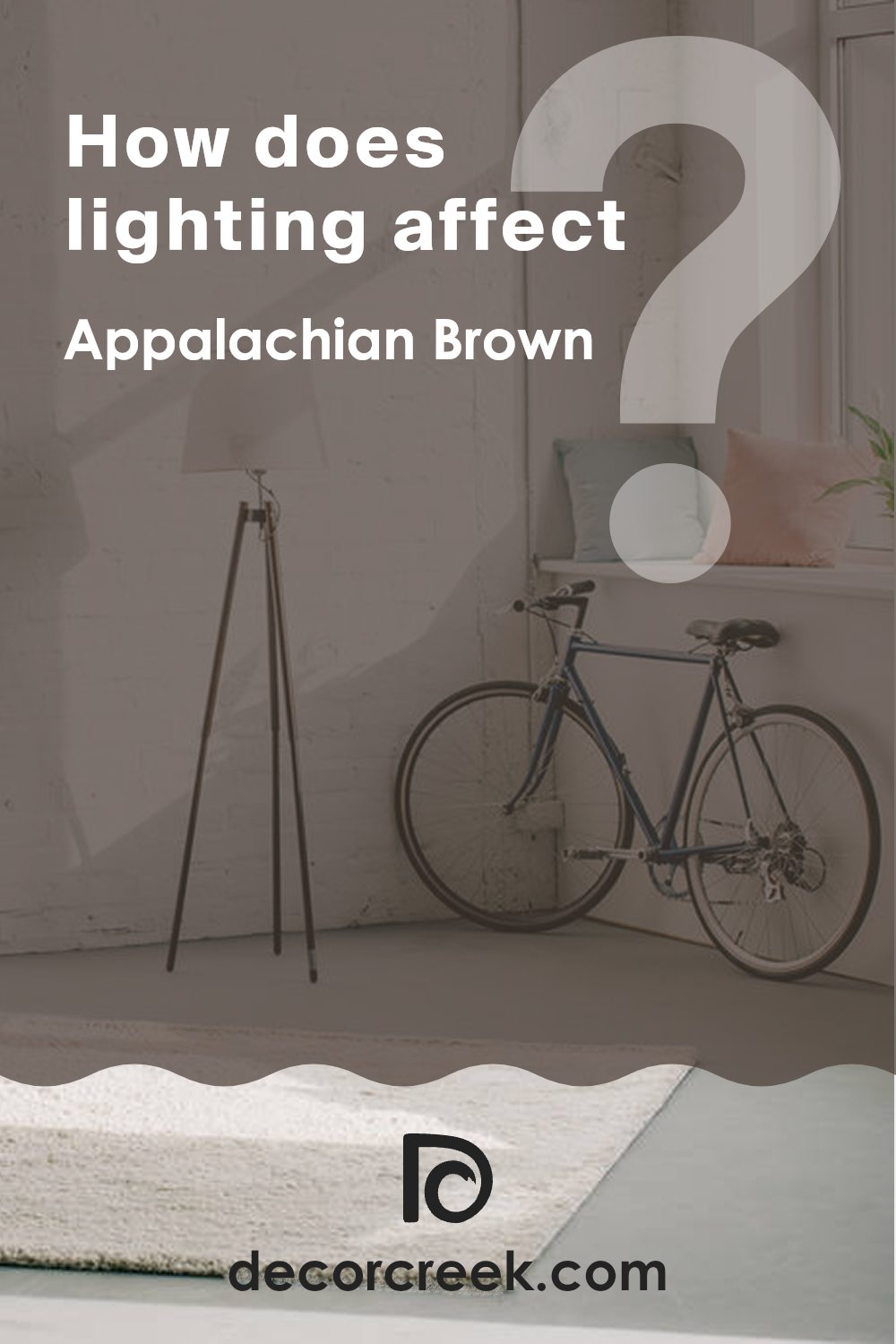
What is the LRV of Appalachian Brown 2115-10 by Benjamin Moore?
LRV stands for Light Reflectance Value, and it measures the amount of light a paint color reflects back into a room. It’s represented on a scale where zero means it reflects no light at all (absorbing all light), making it extremely dark, and values closer to the top of the scale indicate lighter colors that reflect more light.
This measurement is crucial when choosing paint colors because it helps understand how light or dark a color will appear under different lighting conditions. A higher LRV can make a room feel brighter and more open, while a lower LRV can create a cozier and more enveloping mood.
The LRV of Appalachian Brown is 5.97, indicating it’s a very dark color that absorbs most of the light that hits it. This low LRV means it does not reflect much light, contributing to a darker feel within the room.
When used on walls, this deep shade can make a large room feel more intimate and grounded, although it might make a smaller one feel even smaller and darker. It’s important to balance such a dark shade with adequate lighting and perhaps lighter tones in decor or furniture to avoid a room feeling too closed in.
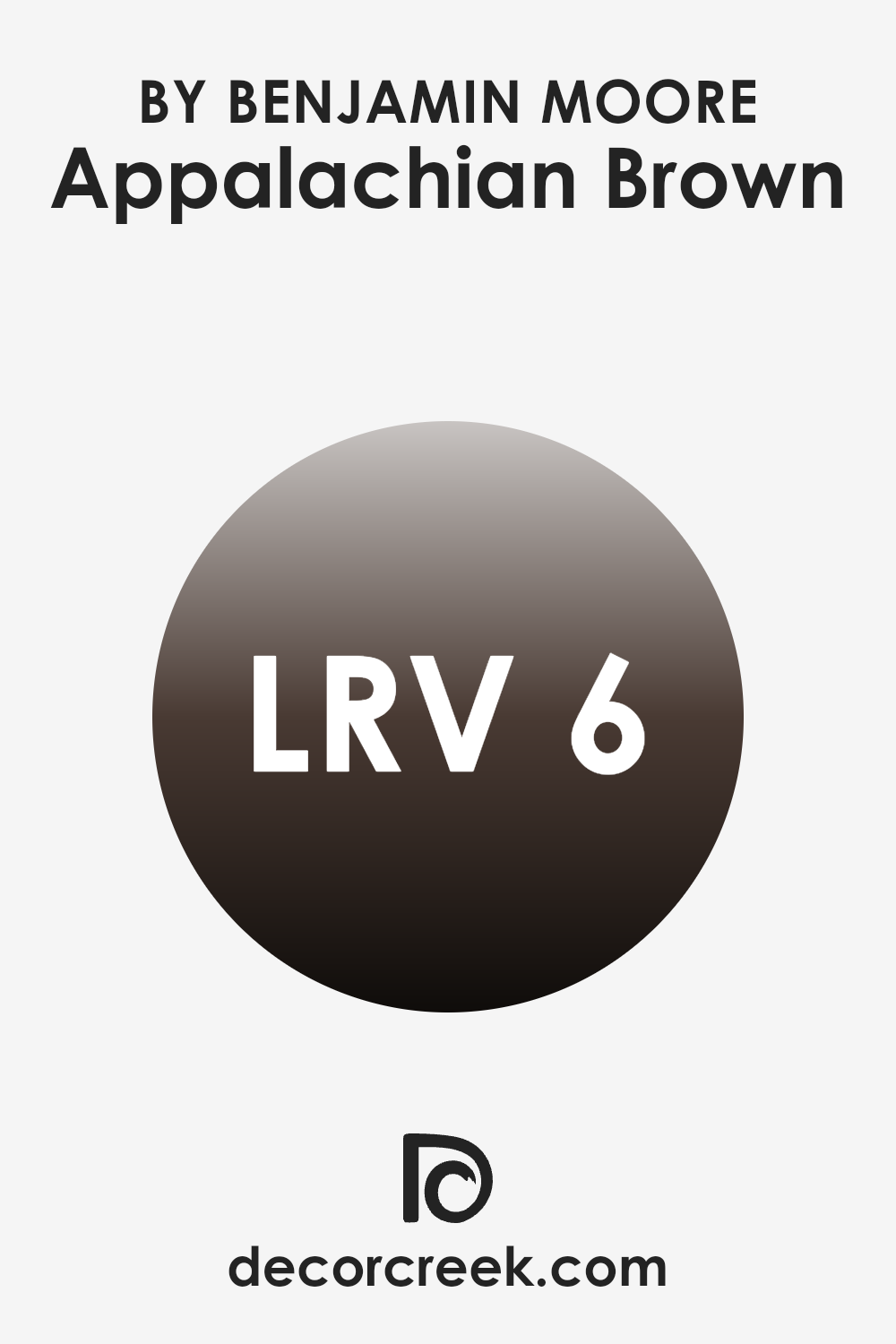
Coordinating Colors of Appalachian Brown 2115-10 by Benjamin Moore
Coordinating colors are hues that complement and enhance each other when used together in a room. The concept involves selecting shades that create a harmonious balance, either by belonging to similar color families or by offering contrast without clashing. Appalachian Brown by Benjamin Moore, a deep and rich tone, can be paired with a variety of coordinating colors to create different moods and aesthetics in your home.
A welcoming color in the lineup is Cotton Tail. This shade is a very light, almost pure white, which gives a crisp contrast to the robust depth of Appalachian Brown, brightening any room with a fresh, airy feel. Summer Harvest brings in a warm, muted hue similar to soft golden wheat, which complements the earthiness of Appalachian Brown, lending a cozy, cohesive look to the room.
For those looking for a touch of subtle refinement, Soft Chinchilla is an excellent choice. This mid-tone gray provides a sleek, modern offset that enhances the warmth of Appalachian Brown without overpowering it. Lastly, Patriotic White offers a slightly cool tone with a hint of blue, providing a refreshing lift that balances well with the darker wood tones of Appalachian Brown. Together, these colors work in concert to create beautiful, balanced rooms in your home.
You can see recommended paint colors below:
- 2155-70 Cotton Tail
- 206 Summer Harvest
- 2135-50 Soft Chinchilla
- 2135-70 Patriotic White
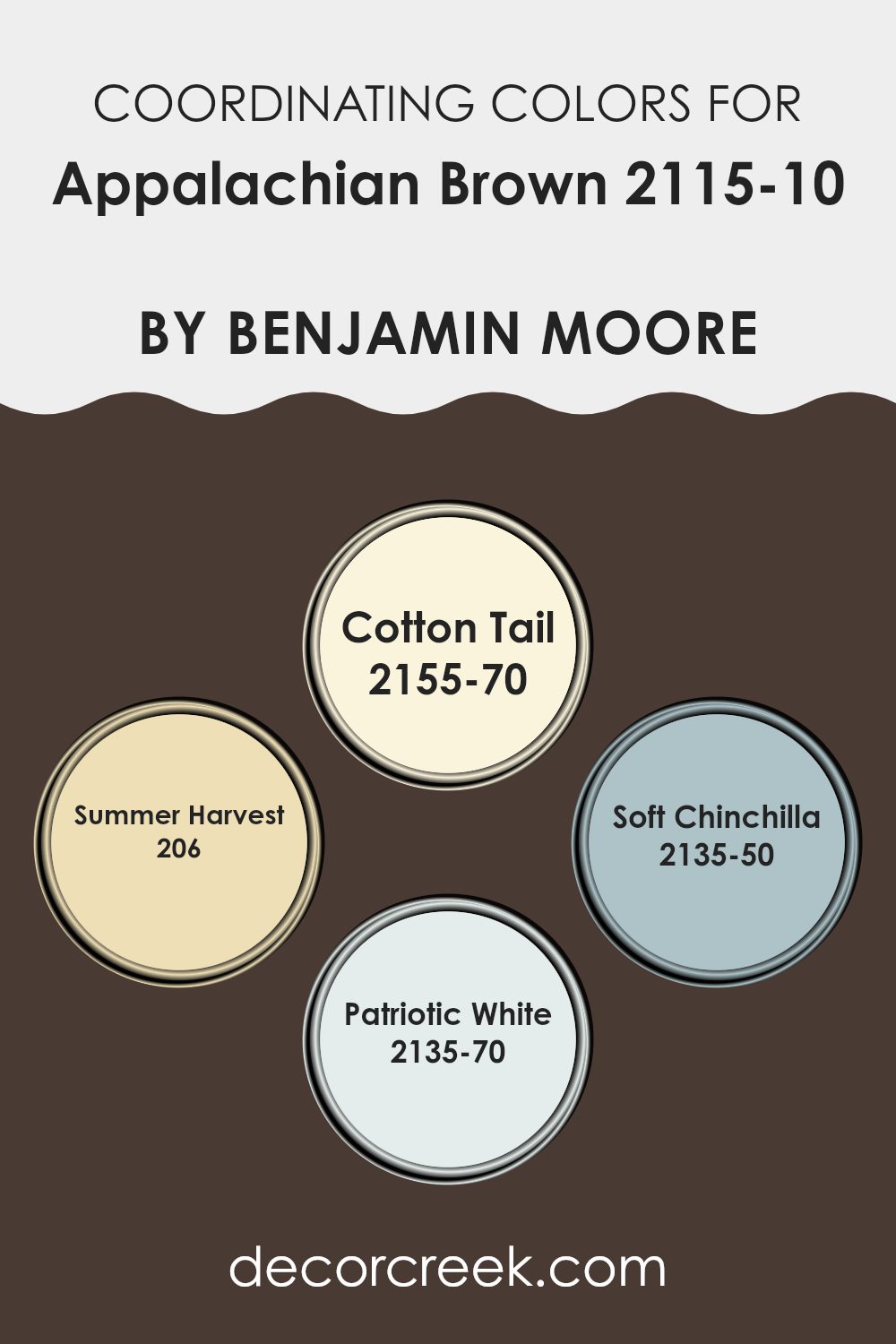
What are the Trim colors of Appalachian Brown 2115-10 by Benjamin Moore?
Trim colors are used to highlight or complement the main color of a room, usually painted along the edges where walls meet ceilings, around doors, windows, and on moldings. For a color like Appalachian Brown by Benjamin Moore, choosing the right trim color is crucial because it helps to either soften or emphasize the rich depth of the dark brown tone.
OC-22 Calm and OC-122 Cotton Balls are both excellent choices for trim colors as they offer a contrast that is not too stark, providing a gentle transition rather than an abrupt shift in color, which enhances the overall aesthetic of a room. OC-22 Calm is a soft, muted beige that can lighten the atmosphere in an area, offering a subtle lift to the darker tones of Appalachian Brown.
It’s like a quiet background that allows other colors to shine without overpowering them. On the other hand, OC-122 Cotton Balls is a clean, crisp white that provides a more pronounced contrast, making it ideal for defining features in a room and highlighting architectural details. Both colors support and emphasize the beauty of Appalachian Brown without competing with its strong presence, making them fitting choices for creating a balanced and pleasing color scheme.
You can see recommended paint colors below:

Colors Similar to Appalachian Brown 2115-10 by Benjamin Moore
Choosing similar colors in interior design can create a harmonious and aesthetically pleasing environment. When colors like Black Bean Soup, Bittersweet Chocolate, Mink, and Night Shade are used alongside Appalachian Brown, they form a cohesive palette that complements each room without making it feel too intense.
These similar hues share a common color base, which allows them to blend seamlessly while still offering enough variation to create depth and visual interest. Using different shades and tints of the same color family allows for a subtle yet impactful design theme that maintains unity.
Black Bean Soup is a deep, dark warm charcoal, almost leaning toward a shade of soft black, that brings a grounding feel to an area. Bittersweet Chocolate, just like its name, offers a rich, deep brown that evokes dark chocolate, adding a lush, comforting touch to any room.
Mink, a slightly lighter shade, carries a softer, more muted brown tone that provides an adaptable backdrop for both bold and neutral decor. Night Shade completes this group with its intense, almost mystical dark hue that adds a sense of drama and refinement to a room. Each of these colors supports the others, enhancing the overall decor scheme beautifully.
You can see recommended paint colors below:
- 2130-10 Black Bean Soup
- 2114-10 Bittersweet Chocolate
- 2112-10 Mink
- 2116-10 Night Shade
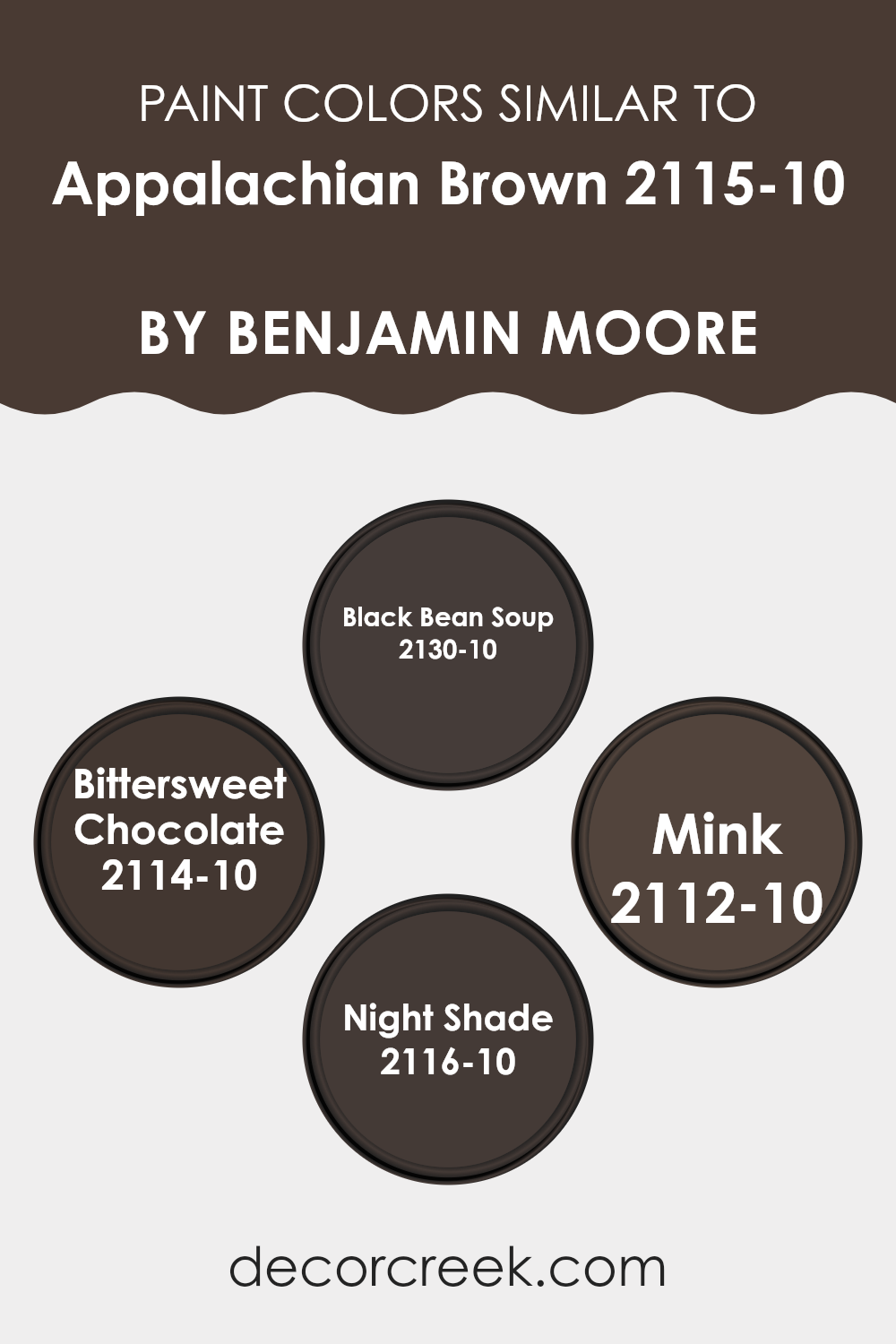
Colors that Go With Appalachian Brown 2115-10 by Benjamin Moore
Choosing the right colors to complement Appalachian Brown 2115-10 by Benjamin Moore is crucial for achieving a harmonious and appealing look in any room. Colors like Majestic Mauve, Iced Mauve, Mauve Blush, Incense Stick, Oyster, and Amazon Soil each bring a unique vibe that enhances the rich depth of Appalachian Brown. Pairing colors thoughtfully can make the design feel cohesive and well balanced, ensuring that the areas feel comfortable yet stylish.
Majestic Mauve is a soft purple with a light and airy quality, offering a gentle contrast to the darker Appalachian Brown. Iced Mauve provides a similar sense of lightness but leans cooler, creating a subtle balance that’s pleasing to the eye. Moving toward a stronger tone, Mauve Blush adds warmth with its deeper pinkish-purple hue, shaping an inviting atmosphere.
Incense Stick, a deep brownish-gray, mirrors the strength of Appalachian Brown, reinforcing the room’s grounded feel. Oyster, the palest shade, acts as a refreshing accent among richer tones, highlighting and balancing the palette. Amazon Soil completes the combination with its deep, earthy red tone that complements the base brown, creating a range from soft to bold—all harmonizing beautifully to enrich the room’s aesthetic.
You can see recommended paint colors below:
- 2115-60 Majestic Mauve
- 2115-50 Iced Mauve
- 2115-40 Mauve Blush
- 2115-20 Incense Stick
- 2115-70 Oyster
- 2115-30 Amazon Soil
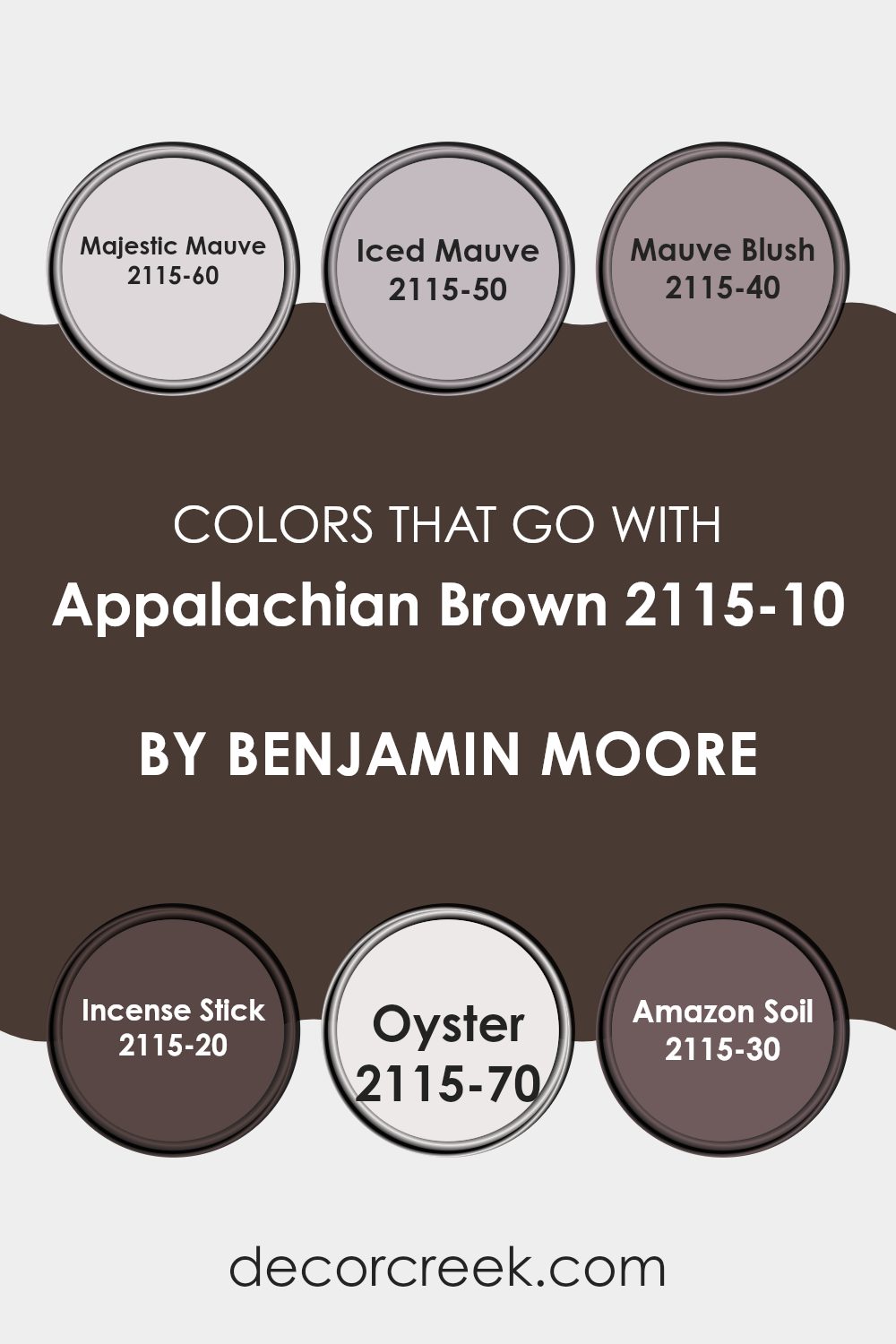
How to Use Appalachian Brown 2115-10 by Benjamin Moore In Your Home?
Appalachian Brown 2115-10 by Benjamin Moore is a deep, rich brown that brings a sense of warmth and comfort to any room. This color is ideal for creating a cozy vibe in your home, perfect for living rooms or bedrooms where you want to relax. When used on walls, it pairs beautifully with lighter furniture or linens, making the room feel welcoming and well-balanced.
You can also use it to paint a single accent wall if you prefer a more subtle hint of warmth. In addition to walls, Appalachian Brown works well on cabinetry or woodwork, providing a classic look that’s enduring. It’s especially nice in a kitchen or bathroom, adding depth and interest to the area.
For those who love a rustic or earthy decor style, this color is a great choice. It can be teamed with natural elements like wooden furniture, linen textiles, and plant life to create an inviting, homey atmosphere.
Appalachian Brown 2115-10 by Benjamin Moore vs Mink 2112-10 by Benjamin Moore
Appalachian Brown and Mink, both by Benjamin Moore, are rich, dark colors perfect for creating a cozy atmosphere in any room. Appalachian Brown has a deep, warm brown tone that brings a comforting and homey feel to interiors. It reflects a natural earthiness, making it a great choice for living rooms or bedrooms that seek a soothing and grounded mood.
On the other hand, Mink, while also quite dark, leans slightly toward a cooler tone compared to Appalachian Brown. It contains subtle gray undertones that give it a more neutral appearance. This makes Mink adaptable for various decorating schemes, whether you’re aiming for a modern look or something more classic.
Overall, both colors add depth and warmth to interiors but in slightly different ways: Appalachian Brown with its warmer, more inviting hues, and Mink with a balanced, more flexible appeal. Choosing between them depends on the specific mood and style you’re aiming to achieve in your room.
You can see recommended paint color below:
- 2112-10 Mink
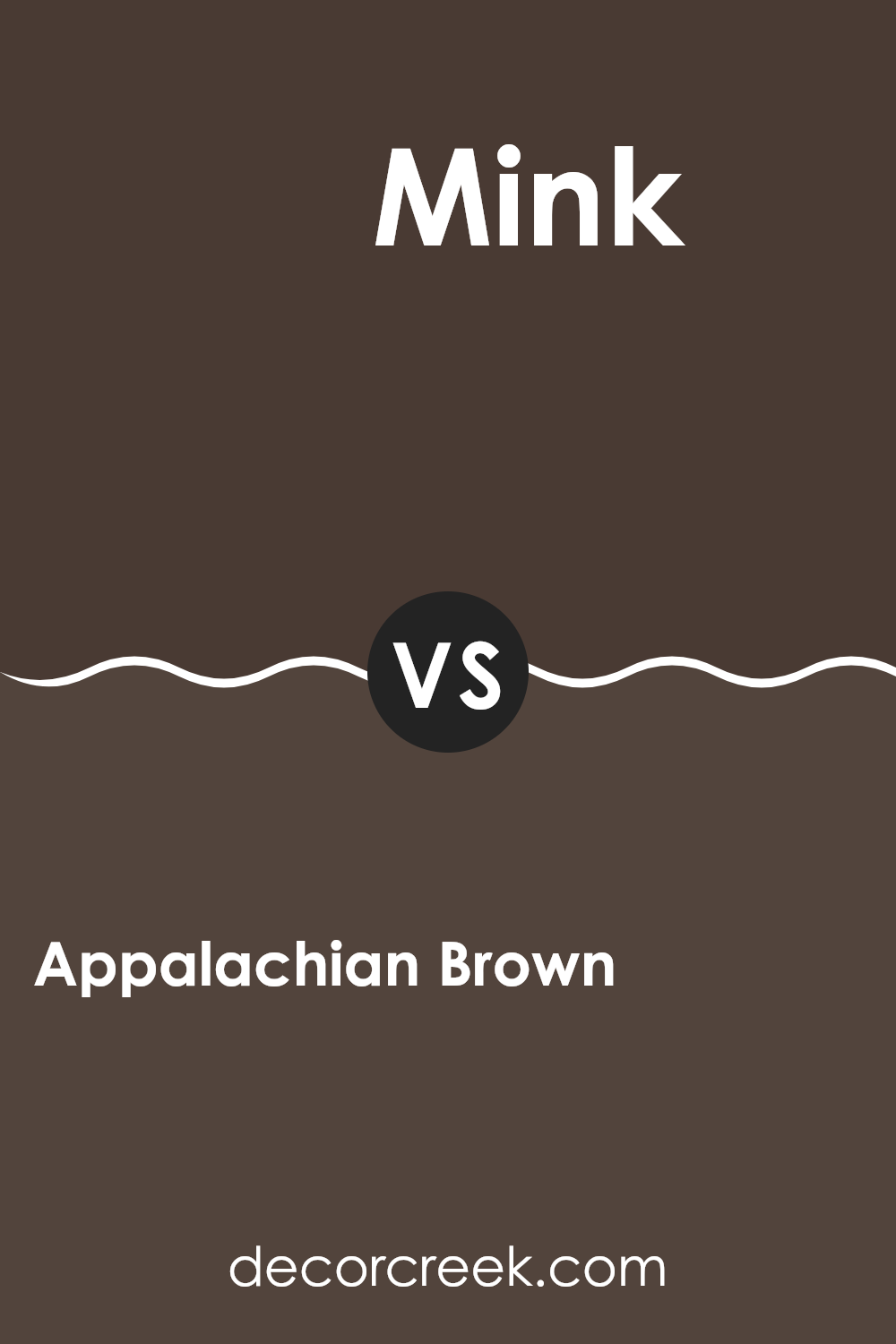
Appalachian Brown 2115-10 by Benjamin Moore vs Black Bean Soup 2130-10 by Benjamin Moore
Appalachian Brown and Black Bean Soup are two intriguing shades by Benjamin Moore. The main color, Appalachian Brown, is a deep, warm brown with notable red undertones that give it a richer feel. This color offers a cozy and inviting ambiance to any room, making it a great choice for living rooms or dining areas.
On the other hand, Black Bean Soup is a very dark shade, closely resembling black but with an underlying richness that prevents it from feeling stark or cold. Its depth can help add a sense of stability and grounding to a room.
Both colors are bold and can easily anchor a room with their intensity, yet they differ in the warmth and vibrancy they bring. Where Appalachian Brown leans slightly toward a softer warmth due to its red undertones, Black Bean Soup offers a purer, more neutral dark base, making it adaptable for adding drama without making a room feel too heavy.
You can see recommended paint color below:
- 2130-10 Black Bean Soup
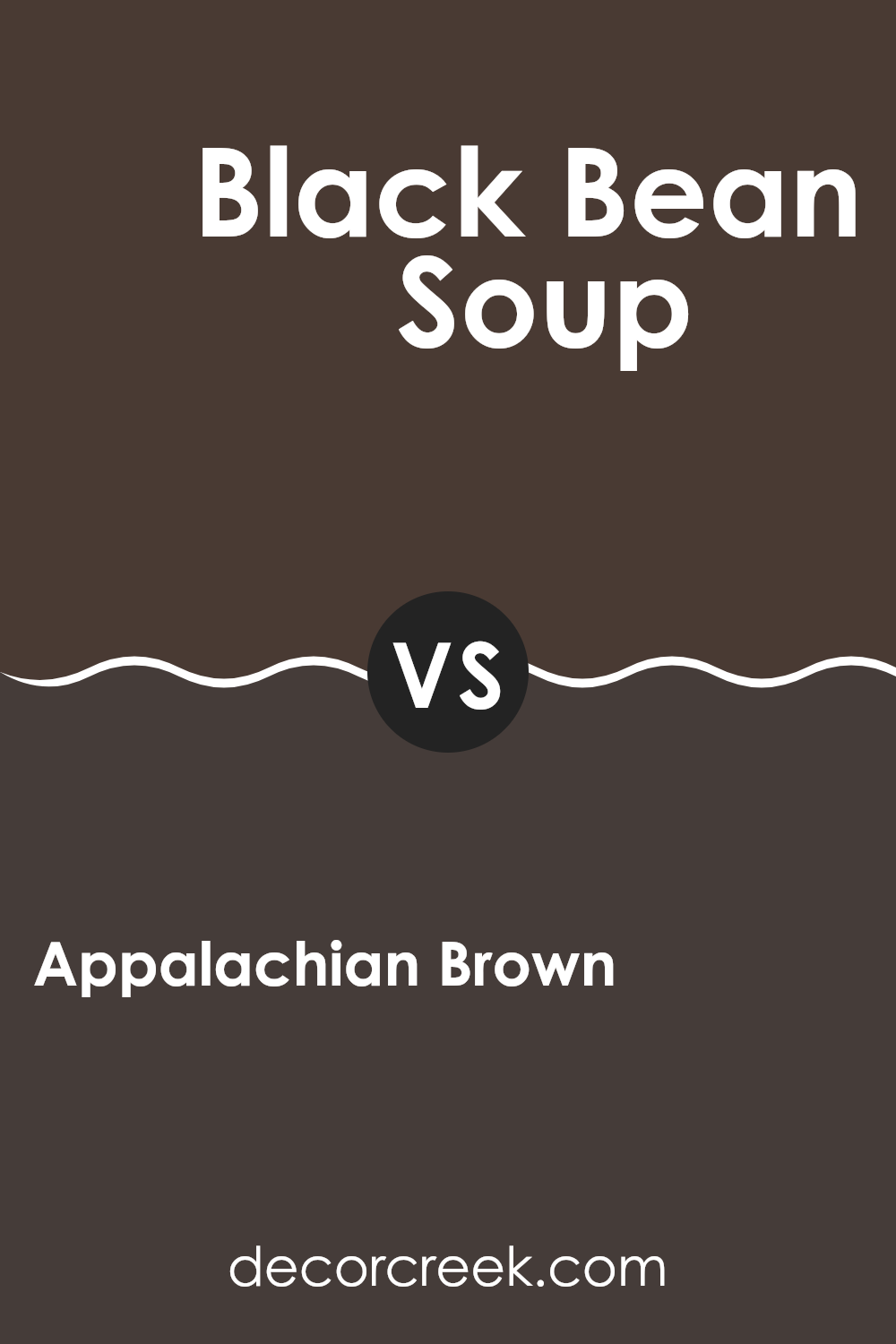
Appalachian Brown 2115-10 by Benjamin Moore vs Bittersweet Chocolate 2114-10 by Benjamin Moore
When comparing Appalachian Brown and Bittersweet Chocolate by Benjamin Moore, you notice distinct yet subtle differences. Appalachian Brown appears as a deep, warm brown, tinged with a slightly reddish hue that makes it quite welcoming and cozy. It’s a great choice for creating a comfortable and inviting mood in rooms like living areas or studies.
On the other hand, Bittersweet Chocolate is a darker shade that looks richer and closer to a true chocolate tone. Its depth provides a bold feel, making it ideal for accent walls or furniture pieces that stand out. The absence of red in its undertones gives it a more neutral quality, which can be easier to pair with different decor styles and color schemes.
Both colors offer strong character and a sense of warmth, but while Appalachian Brown softens a room with its gentle red undertones, Bittersweet Chocolate delivers more drama and impact thanks to its deeper and more striking nature.
You can see recommended paint color below:
- 2114-10 Bittersweet Chocolate

Appalachian Brown 2115-10 by Benjamin Moore vs Night Shade 2116-10 by Benjamin Moore
Appalachian Brown and Night Shade, both by Benjamin Moore, are distinct yet related shades. Appalachian Brown is a deep, warm brown with a rich and earthy tone. It gives a cozy and inviting feel to any room, making it ideal for living areas or studies where you want to feel relaxed and comfortable.
On the other hand, Night Shade is almost black, with subtle hints of blue that give it a unique character. This color is cooler and more intense, providing a bold and dramatic look. It’s perfect for accent walls or rooms where you want to make a strong style statement.
Together, these colors can work beautifully if you’re aiming for a striking contrast—Appalachian Brown adding warmth and Night Shade offering depth and drama. They can also stand on their own, each setting a distinct mood depending on the atmosphere you want to create in a room.
You can see recommended paint color below:
- 2116-10 Night Shade
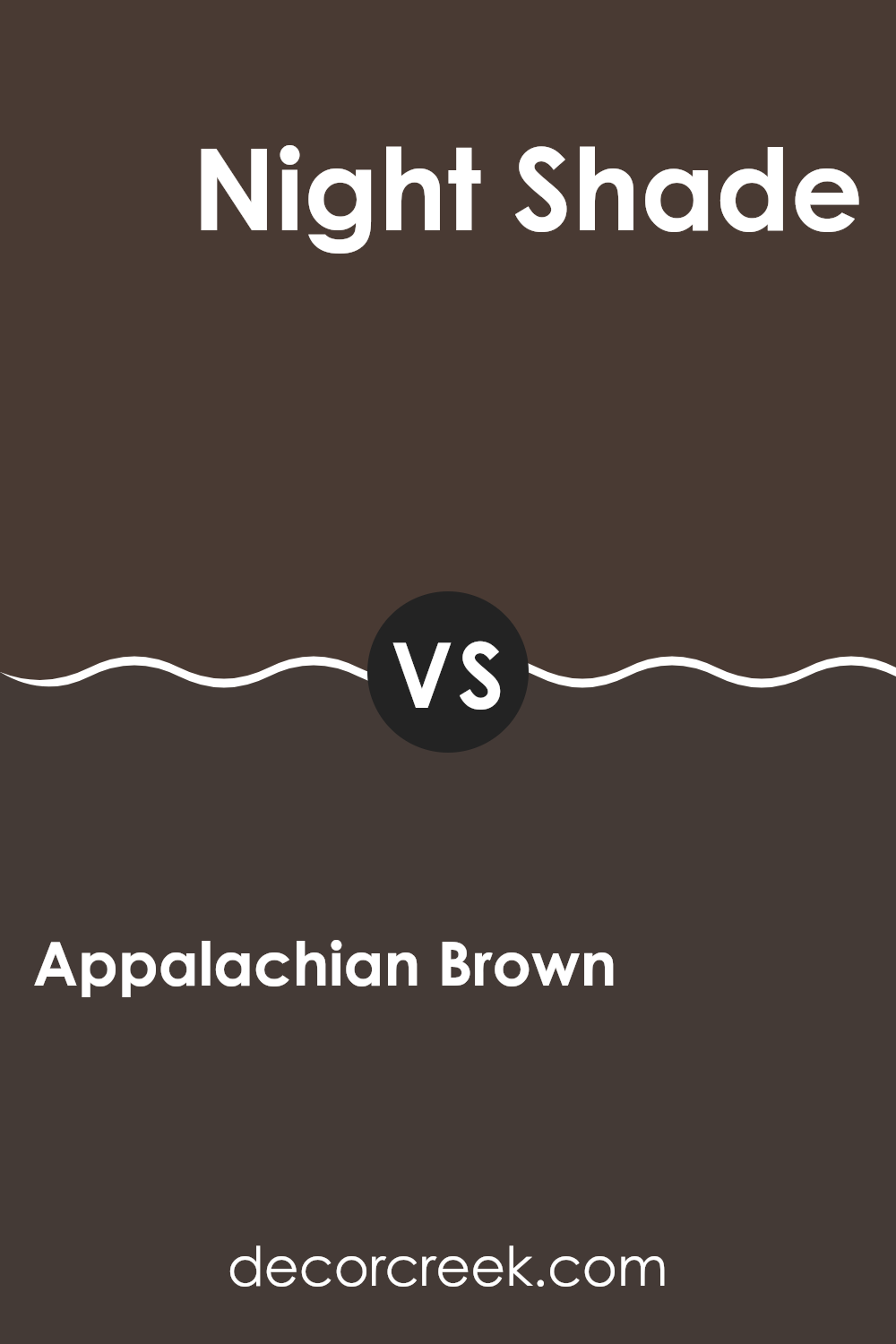
After spending some time talking about the paint 2115-10 Appalachian Brown by Benjamin Moore, I think it’s a really nice choice for making a room look cozy and warm. This color reminds me of delicious dark chocolate and feels perfect for someone who enjoys a snug, comfortable setting, especially in rooms like the living room or study.
Benjamin Moore did a great job with this paint because it goes on smoothly and not only looks beautiful but also holds up well over time. It covers walls evenly, giving any room a polished and well-balanced look. Whether you have plenty of furniture or prefer a simpler layout, Appalachian Brown helps everything blend naturally.
Overall, using Appalachian Brown paint is a smart choice if you want to make your room feel warmer and more welcoming. It’s simple yet highly effective in changing the overall mood of a room without doing anything drastic.
This color can make any room stand out gracefully while creating a true sense of comfort and home.

Ever wished paint sampling was as easy as sticking a sticker? Guess what? Now it is! Discover Samplize's unique Peel & Stick samples.
Get paint samples



